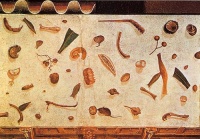Ik ken twee Robert Irwins. De ene is een schrijver en leeft nog. Ik las ooit het boek Exquisite corpse van hem toen ik op vakantie was in Le Crotoy. Irwin blijkt ook een intellectuele tegenstander van Edward Said te zijn, zoals ik dat ben.
Maar de Robert Irwin die stierf was een visueel kunstenaar die ooit als abstract expressionist begon. Al vrij snel kwam hij tot de slotsom dat zijn werk in dat genre waardeloos was. Je kan een van zijn schilderijen nog zien op de hoes van The Trumpet Artistry of Chet Baker (1954). Nogal wat jazzplaten hadden hoezen met abstract expressionistische schilderijen want de band tussen jazz en abstract impressionisme was vrij innig. Beiden werden beschouwd als improvisatorische performancekunsten en deelden hetzelfde publiek.
Continue reading
